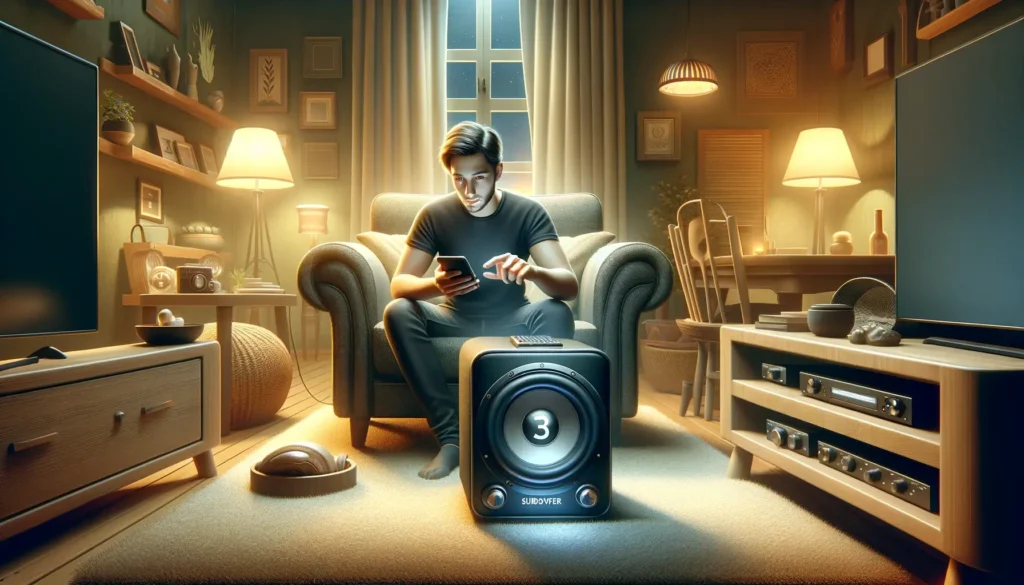
Are you struggling with how to get deep bass from subwoofer? You’re in the right place. Deep bass is the heartbeat of any audio system, creating an immersive experience that resonates within us.
As an enthusiast who has navigated the complex world of audio equipment, I understand the challenge. In this guide, we’ll dive into practical tips and insights to help you achieve that powerful, deep bass from your subwoofer.
We’ll explore all the essential steps, from optimal placement to fine-tuning settings. Join me in transforming your listening experience with the deep, impactful bass you’ve longed for.
How to Get Deep Bass from Subwoofer?
Placement and Room Acoustics

How the Placement of a Subwoofer Affects Sound Quality
Have you ever noticed how moving around in a room can change how music sounds? That’s because where we put things like speakers and subwoofers matters. The same song can sound different in each corner of your room. For deep bass, where you place your subwoofer is key.
If you put it in a corner, the walls can help make the bass sound stronger. But be careful, sometimes this can make it too boomy. We want deep bass, not messy noise! Try different spots and listen. We’re looking for a place where your bass feels just right – strong, clear, and not echoing.
Tips for Optimizing Room Acoustics for Deeper Bass:
Remember, what works in one room might not work in another. So, take your time and have fun testing! The perfect spot for your subwoofer is out there. And once you find it, you’ll feel the difference in the deep bass. Learn more which subwoofer box is best for deep bass
Setting Up Your Subwoofer for Deep Bass:

Getting deep, powerful bass from your subwoofer isn’t just about buying the best equipment; it’s about setting it up correctly. Let’s walk through the steps to optimize your subwoofer for deep bass.
Deep Bass Subwoofer Setup: Start with Placement
We’ve already discussed Subwoofer Placement Tips so you know where to put your subwoofer. Now, let’s set it up for the best performance. Place your subwoofer in the spot you found best during your tests – remember, a little away from the wall is usually a good start.
Optimizing Subwoofer Bass: Connect and Adjust
Connect your subwoofer to your audio system. Make sure all the cables are secure and in the right place. Loose cables can mess with the sound quality.
Best Subwoofer Settings for Deep Bass: Crossover Frequency
The crossover frequency is like a traffic cop. It tells your subwoofer what low sounds to play and stops the higher sounds. For deep bass, you want to set this just right.
A common setting is around 80 Hz, but this can change based on your speakers and room. Experiment a bit. If your bass sounds muddy, try a lower setting. If it’s missing the deep notes, go higher.
Understanding Phase Settings
The phase setting helps your subwoofer work well with other speakers. If it’s off, the bass can sound weak or weird. Try setting it to 0 degrees first.
If the bass seems stronger at certain spots in your room but weaker in others, switch the phase to 180 degrees and listen again. Choose the setting that gives the most even, powerful bass across the room.
Fine-Tuning for the Perfect Sound
Now, sit back in your favorite listening spot and play some music or a movie with good bass. Listen carefully. Adjust the volume and settings until the bass feels deep, clear, and powerful.
Choosing the Right Subwoofer for Deep Bass:

When it comes to getting that perfect deep bass, choosing a subwoofer is crucial. Here’s how to pick one that suits your needs and enhances your audio experience. learn more how to choose right subwoofer enclosure for deep bass
Factors to Consider for Deep Bass Subwoofer Setup
- Power: This is about how loud your subwoofer can get. More power means it can handle louder sounds without distortion. But remember, more power doesn’t always mean better quality. Balance is key.
- Size: Size matters in subwoofers. Larger ones usually provide deeper bass, but they need more space. Think about your room size before deciding.
- Frequency Range: This tells you how low your subwoofer can go. For deep bass, look for a subwoofer that can hit low frequencies, typically around 20-30 Hz.
Subwoofer Buying Guide for Different Budgets and Room Sizes
- Budget-Friendly Options: You don’t have to break the bank for good bass. Many affordable subwoofers offer decent performance. Look for ones with good reviews and essential features.
- For Small Rooms: A smaller subwoofer can work wonders in a cozy space. You don’t need too much power here. A compact, high-performance subwoofer is ideal.
- For Large Rooms: This is where you can unleash the big guns. Larger, higher-power subwoofers will fill your space with rich, deep bass. Just ensure your room acoustics support it.
Calibration and Fine-Tuning:

How to Calibrate Your Subwoofer for Optimal Performance?
Have you ever wondered how to make your subwoofer sound just perfect? It’s all about calibration – adjusting it to work best in your space. Here’s a simple guide:
- Start with Volume: Set your subwoofer’s volume to a moderate level. You want it loud enough to hear adjustments but not so loud that it’s overwhelming.
- Find the Right Crossover Frequency: This is where your subwoofer takes over from your speakers. A good starting point is around 80 Hz, but this can vary. Play a song with a steady bass and adjust the crossover until the bass sounds smooth and integrated with your speakers.
- Adjust the Phase Control: This helps your subwoofer sync up with your speakers. Play bass-heavy music and switch between the phase settings (usually 0 or 180 degrees). Choose the setting where the bass sounds fuller.
- Fine-tune with Your Ears: Sit in your favorite listening spot and listen. Adjust the volume and settings slightly until you get the deep, clear bass you love.
Tools and Apps That Can Help in Calibration:
We live in a great time for technology, and there are tools and apps to make calibration even easier:
- Sound Meter Apps: These can measure the sound levels in your room, helping you find the right volume and balance.
- Subwoofer Calibration Tools: Some specialized tools and apps are designed for subwoofer setup. They can guide you through adjustments like phase and crossover settings.
- Room Acoustic Analyzer Apps: These are amazing. They analyze how sound behaves in your room and suggest adjustments to improve your subwoofer’s performance.
Remember, every room is different, so what works in one space might not work in another. Trust your ears and take your time. Calibration is all about tweaking things until they sound just right for you.
How to get deep bass from a car subwoofer?

Turning Your Car into a Bass-Heavy Haven
Do you want that heart-thumping, deep bass in your car that makes every drive an experience? Achieving this is all about understanding your car subwoofer and how to optimize it. Let’s break it down into simple steps:
Remember, achieving deep bass in a car is a bit different from doing so in a room. The confined space and different acoustics mean you might have to experiment more. But with these tips, you’re well on your way to enjoying deep, resonating bass on every drive.
Common Mistakes to Avoid:

Ensuring Deep Bass Without the Hassles:
Getting deep bass from your subwoofer can be tricky, and slipping up is easy. Here are some common mistakes you should avoid:
- Overlooking Room Size: We often forget how much our room size and shape affect sound. A subwoofer too big for a small room can create a boomy effect, while a small one in a large room might feel underwhelming.
- Ignoring Placement: Remember, the spot where you place your subwoofer greatly impacts its performance. Avoid corners if you’re getting too much boominess. Experiment with different locations to find the best sound.
- Wrong Settings: It’s tempting to crank up the bass or volume, but this often leads to distortion. Aim for balance. Adjust the crossover frequency and volume to integrate seamlessly with your main speakers.
- Neglecting Calibration: Every room has its unique acoustics. Failing to calibrate your subwoofer to your room’s specifics can mean missing out on optimal bass quality.
- Forgetting About Phase Adjustment: If your subwoofer and speakers aren’t in phase, the sound can cancel out, leading to weak bass. Check the phase settings if the bass isn’t punchy enough.
How to Troubleshoot Common Subwoofer Issues?

Even with everything set up right, you might face some issues. Here’s how to troubleshoot them:
- No Sound from Subwoofer: First, check all the connections. Ensure the cables are plugged in properly, and the power is on. Then, check if your receiver or amplifier settings are correctly configured.
- Weak Bass: Try adjusting the placement if the bass isn’t as strong as you’d like. Sometimes, moving it just a few inches can make a huge difference. Also, revisit your crossover and volume settings.
- Distorted or Boomy Bass: This often happens when the volume or bass boost is too high. Dial it back a bit. Also, check if the subwoofer is too close to walls or corners.
- Humming or Buzzing Sounds: This could be due to electrical interference. Check your power connections and cables. Sometimes, using a different outlet can solve this issue.
- Intermittent Bass: This could be due to loose connections or issues with the receiver. Double-check all connections and ensure your receiver is functioning correctly.
Remember, getting deep bass from your subwoofer is about balance, tuning, and patience. Avoid these common mistakes, and you’ll be on your way to experiencing the powerful, deep bass you desire.
Enhancing Bass with Additional Equipment:

Boosting Your Bass to the Next Level:
Sometimes, you want that extra punch in your bass, and the standard setup isn’t enough. That’s where additional equipment like equalizers and bass boosters comes in. Let me guide you through their roles and when it’s worth investing in them.
The Role of Equalizers:
Think of an equalizer (EQ) as your sound sculpting tool. It lets you adjust different frequencies to get the sound just right. For deep bass:
- Boost the Low Frequencies: Gently increase the lower frequency bands. But be careful, too much, and it might get muddy.
- Balance is Key: While boosting the bass, ensure it’s not overpowering the mid and high frequencies. We’re aiming for rich, deep bass, not a sound that’s all bass and nothing else.
Bass Boosters and Their Magic:
Bass boosters are like a turbo-charge for your bass. They specifically amplify the low frequencies. Great for genres that thrive on bass, like hip-hop or electronic music.
- Use Sparingly: It’s easy to overdo it with bass boosters. A little goes a long way.
- Watch for Distortion: If you start hearing distortion, it’s a sign to dial it back.
Other Accessories Worth Considering:
- Subwoofer Isolation Pads: These reduce vibrations and can clean up the bass sound, especially in apartments or shared spaces.
- High-Quality Cables: Good cables can improve the overall sound quality, ensuring you get the best from your equipment.
- External Amplifiers: For those really serious about their bass, an external amp can give your subwoofer the power it needs to perform at its best.
When to Invest in Extra Equipment
Investing in additional equipment depends on your needs:
- For Audiophiles: If you’re really passionate about sound, these investments can significantly enhance your listening experience.
- Inadequate Bass Response: If your current setup isn’t delivering the bass you need, these tools can help.
- Home Theater Enthusiasts: For a more immersive movie-watching experience, tweaking your bass can make all the difference.
Remember, it’s all about enhancing the experience without overwhelming it. You can take your bass from good to great with the right balance and equipment.
Maintenance Tips of Subwoofers:

Keeping Your Bass Deep and Your Subwoofer Happy
Regular maintenance is key to enjoying your subwoofer’s deep bass. It’s not just about performance; it’s also about making your subwoofer last longer. Here are some simple yet effective tips:
Keep It Clean
- Dust and dirt can be sneaky enemies of electronic equipment. Use a soft, dry cloth to wipe down your subwoofer gently.
- Avoid letting dust accumulate on the speaker cone. It can affect sound quality.
Check Connections Regularly
- Loose cables are a common issue. Periodically make sure all connections are tight and secure.
- If you’re using wired connections, inspect the wires for any signs of wear or damage.
Give It Space
- Subwoofers need good airflow to prevent overheating. Make sure there’s enough space around your subwoofer for air to circulate.
- Avoid placing it in enclosed spaces where heat can build up.
Manage the Volume
- We all love that powerful bass, but consistently playing your subwoofer at extremely high volumes can strain it.
- Enjoy the deep bass at a reasonable volume. This helps in maintaining the longevity of the subwoofer.
Avoid Moisture and Extreme Temperatures
- Keep your subwoofer away from damp areas. Moisture can damage the electronic components.
- Also, extreme cold or heat can affect its performance and longevity. Room temperature is best.
Regular Function Checks
- Occasionally, play a variety of music and listen for any unusual sounds. Distortion, rattling, or lack of clarity can indicate something’s off.
- Early detection of issues can save a lot of hassle later.
Firmware and Software Updates
- If your subwoofer has digital features or connects to an app, update its software. Manufacturers often release updates that improve performance and fix bugs.
By following these maintenance tips, you’re not just ensuring that your subwoofer continues to produce that deep, enveloping bass. You’re also making sure it stays a part of your audio setup for years.
FAQs:
1. What is the best subwoofer for deep bass?
Finding the best subwoofer for deep bass depends on your room size and budget. Generally, look for a subwoofer with a good power output, larger size for bigger rooms, and a low frequency range (around 20-30 Hz). Brands like SVS, Klipsch, and Yamaha are known for their deep bass capabilities.
2. How to get clean bass from subwoofer?
To get clean bass from subwoofer:
- Ensure proper placement – not too close to walls or corners.
- Set the right crossover frequency – usually around 80 Hz.
- Keep the volume at a balanced level to avoid distortion.
- Regularly maintain your subwoofer, keeping it dust-free.
3. How to turn up bass on subwoofer?
To turn up the bass on subwoofer:
- Adjust the volume or gain control on your subwoofer.
- Experiment with the bass boost feature if available, but use it sparingly.
- Check the equalizer settings on your main audio system and increase the lower frequencies.
4. What makes a subwoofer have deep bass?
A subwoofer has deep bass due to:
- Its design, which allows it to move more air and produce lower frequencies.
- The size of its driver – larger drivers generally produce deeper bass.
- The quality of its build and the power of its amplifier.
- Proper calibration and room placement to maximize its performance.
Conclusion:
So, we’ve explored how to get deep bass from subwoofer. Remember, it’s not just about having a big subwoofer but also about where you put it and how you set it up.
We learned that placing the subwoofer a bit away from the walls and trying different spots in the room can make a big difference. And don’t forget the ‘crawl test’ – it’s a fun way to find the best spot for your subwoofer.
We also discussed setting the right crossover frequency and adjusting the phase settings. These might sound tricky, but they’re like solving a puzzle – with each bit of adjustment, you get closer to that perfect deep bass sound. And for our friends who love to drive with music, we didn’t forget about getting great bass in your car, too.
Choosing the right subwoofer is like picking a new friend who loves music as much as you do. Whether for a cozy room or a big space, there’s a perfect match for everyone.
And, like any good friendship, taking care of your subwoofer with regular cleaning and check-ups means it will always be there to bring music to your life.
I encourage you to try these tips and play around with your setup. It’s all about experimenting and listening. You might be surprised how small changes can bring out the deep, powerful bass that transforms your favorite songs or movies. And remember, it’s your space and your sound – make it just how you love it!
Now, enjoy the deep, resonating bass from your subwoofer. Dance, relax, or just lose yourself in the music. That’s the magic of great sound – it brings joy to our lives. And isn’t that what it’s all about? Happy listening!







